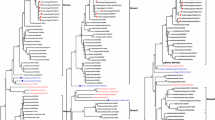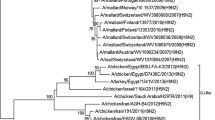Abstract
Since the incursion of avian influenza virus subtype H5N8 in Egypt in late 2016, it has spread rapidly, causing severe losses in poultry production. Multiple introductions of different reassorted strains were observed in 2017. In this study, a genetic characterization of the HA gene was carried out with 31 isolates selected from different governorates and sectors. Fifteen isolates were selected for NA gene sequence analysis. The HA and NA genes were divided into two subgroups (I and II) with positive selection pressure identified at positions 174 and 29, respectively. The HA gene contained two novel mutations in the antigenic sites, A and E. The HA nucleotide sequence identity ranged from 77 to 90% with different vaccine seeds. Full-genome sequence analysis was carried out for eight viruses, representing different governorates and sectors, to identify the predominant reassorted strain in Egypt. All viruses were similar to a reassorted strain of clade 2.3.4.4b that has been identified in Germany, among other countries. Analysis of these viruses revealed mutations specific to Egyptian strains and not the original virus characterized in 2017 (A/duck/Egypt/F446/2017), with a novel antiviral resistance marker, V27A, indicating resistance to amantadine in the M2 protein of two strains. The results indicate increased variability of circulating H5N8 viruses compared to earlier viruses sequenced in 2016 and 2017. The predominant reassorted virus circulating in 2017 and 2018 originated from an early 2017 strain. It is important to continue this surveillance of avian influenza viruses to monitor the evolution of circulating viruses.






Similar content being viewed by others
References
Anis A, AboElkhair M, Ibrahim M (2017) Characterization of highly pathogenic avian influenza H5N8 virus from Egyptian domestic waterfowl in 2017. Avian Pathol. https://doi.org/10.1080/03079457.2018.1470606
Arnold K, Bordoli L, Kopp J, Schwede T (2006) The SWISS MODEL workspace: a webbased environment for protein structure homology modelling. Bioinformatics 22:195–201
Bouwstra R, Heutink R, Bossers A, Harders F, Koch G et al (2015) Full-genome sequence of influenza A(H5N8) virus in poultry linked to sequences of strains from Asia, the Netherlands, 2014. Emerg Infect Dis 21:872–874
Chen GW, Chang SC, Mok CK, Lo YL, Kung YN et al (2006) Genomic signatures of human versus avian influenza A viruses. Emerg Infect Dis 12(9):1353–1360
de Vries E, Guo H, Dai M et al (2015) Rapid emergence of highly pathogenic avian influenza subtypes from a subtype H5N1 hemagglutinin Variant. Emerg Infect Dis 21(5):842–846. https://doi.org/10.3201/eid2105.141927
Delport W, Poon AF, Frost SD, Kosakovsky Pond SL (2010) Datamonkey 2010: a suite of phylogenetic analysis tools for evolutionary biology. Bioinformatics 26:2455–2457. https://doi.org/10.1093/bioinformatics/btq429
Durrant MG, Eggett DL, Busath DD (2015) Investigation of a recent rise of dual amantadine-resistance mutations in the influenza A M2 sequence. BMC Genet 16(Suppl 2):S3. https://doi.org/10.1186/1471-2156-16-s2-s3
Escorcia M, Vázquez L, Méndez ST, Rodríguez-Ropón A, Lucio E, Nava GM (2008) Avian influenza: genetic evolution under vaccination pressure. Virol J 5:15
Gupta R, Jung E, Brunak S (2004) Prediction of N-glycosylation sites in human proteins. 46:203–206. http://www.cbs.dtu.dk/services/NetNGlyc
Hall JS, Dusek RJ, Spackman E (2015) Rapidly expanding range of highly pathogenic avian influenza viruses. Emerg Infect Dis 21:1251–1252
Hoper D, Hoffmann B, Beer M (2009) Sequencing of complete H5N1 avian influenza virus genomes. J Clin Microbiol 47:674–679
Jeong J, Kang HM, Lee EK, Song BM, Kwon YK et al (2014) Highly pathogenic avian influenza virus (H5N8) in domestic poultry and its relationship with migratory birds in South Korea during 2014. Vet Microbiol 173:249–257
Kandeil A, Kayed A, Moatasim Y, Webby RJ, McKenzie PP, Kayali G, Ali MA (2017) Genetic characterization of highly pathogenic avian influenza A H5N8 viruses isolated from wild birds in Egypt. J Gen Virol 98:1573–1586
Kandeil A, Sabir JSM, Abdelaal A, Mattar EH, ElTaweel AN, Sabir MJ, Khalil AA, Webby R, Kayali G, Ali MA (2018) Efficacy of commercial vaccines against newly emerging avian infuenza H5N8 virus in Egypt. Sci Rep 8:9697
Kanehira K, Uchida Y, Takemae N, Hikono H, Tsunekuni R et al (2015) Characterization of an H5N8 influenza A virus isolated from chickens during an outbreak of severe avian influenza in Japan in April 2014. Arch Virol 160:1629–1643
Kim JK, Seiler P, Forrest HL, Khalenkov AM, Franks J, Kumar M, Karesh WB, Gilbert M, Sodnomdarjaa R, Douangngeun B, Govorkova EA, Webster RG (2008) Pathogenicity and vaccine efficacy of different clades of Asian H5N1 avian influenza A viruses in domestic ducks. J Virol 82:11374–11382. https://doi.org/10.1128/JVI.01176-08
Lee CW, Senne DA, Suarez DL (2004) Effect of vaccine use in the evolution of Mexican lineage H5N2 avian influenza virus. J Virol 78:8372–8381
Lee YJ, Kang HM, Lee EK, Song BM, Jeong J et al (2014) Novel reassortant influenza A(H5N8) viruses, South Korea, 2014. Emerg Infect Dis 20:1087–1089
Lee DH, Torchetti MK, Winker K, Ip HS, Song CS, Swayne DE (2015) Intercontinental spread of Asian-origin H5N8 to North America through Beringia by Migratory Birds. J Virol 89:6521–6524
Lee DH, Sharshov K, Swayne DE, Kurskaya O, Sobolev I, Kabilov M, Alekseev A, Irza V, Shestopalov A (2017) Novel Reassortant Clade 2.3.4.4 Avian influenza A(H5N8) virus in wild aquatic birds, Russia, 2016. Emerg Infect Dis 23:359–360
Lycett SJ, Ward MJ, Lewis FI, Poon AF, Kosakovsky Pond SL, Kosakovsky Pond AJ, Brown Leigh (2009) Detection of mammalian virulence determinants in highly pathogenic avian influenza H5N1 viruses: multivariate analysis of published data. J Virol 83(19):9901–9910
Marchenko VY, Susloparov IM, Kolosova NP, Goncharova NI, Shipovalov AV et al (2015) Influenza A(H5N8) virus isolation in Russia, 2014. Arch Virol 160:2857–2860
Mertens E, Dugan VG, Stockwell TB, Lindsay LL, Plancarte M, Boyce WM (2013) Evaluation of phenotypic markers in full genome sequences of avian influenza isolates from California. Comp Immunol Microbiol Infect Dis 36:521–536. https://doi.org/10.1016/j.cimid.2013.06.003
Nagarajan S, Kumar M, Murugkar HV, Tripathi S, Shukla S, Agarwal S, Dubey G, Nagi RS, Singh VP, Tosh C (2017) Novel reassortant highly pathogenic avian influenza (H5N8) virus in zoos, India. Emerg Infect Dis 23:717–719
Naguib MM, Arafa AS, El-Kady MF, Selim AA, Gunalan V, Maurer-Stroh S, Goller KV, Hassan MK, Beer M, Abdelwhab EM, Harder TC (2015) Evolutionary trajectories and diagnostic challenges of potentially zoonotic avian influenza viruses H5N1 and H9N2 co-circulating in Egypt. Infect Genet Evol 34:278–291
Neumann G, Kawaoka Y (2006) Host range restriction and pathogenicity in the context of influenza pandemic. Emerg Infect Dis 12(6):881–886
Nguyen LT, Schmidt HA, von Haeseler A, Minh BQ (2014) IQ-TREE: a fast and effective stochastic algorithm for estimating maximum likelihood phylogenies. Mol Biol Evol
Pasick J, Berhane Y, Joseph T, Bowes V, Hisanaga T et al (2015) Reassortant highly pathogenic influenza A H5N2 virus containing gene segments related to Eurasian H5N8 in British Columbia, Canada, 2014. Sci Rep 5:9484
Pohlmann A, Starick E, Harder T, Grund C, Hoper D, Globig A, Staubach C, Dietze K, Strebelow G, Ulrich RG, Schinkothe J, Teifke JP, Conraths FJ, Mettenleiter TC, Beer M (2017) Outbreaks among wild birds and domestic poultry caused by reassorted influenza A(H5N8) Clade 2.3.4.4 viruses, Germany, 2016. Emerg Infect Dis 23:633–636
Salaheldin AH, El-Hamid HS, Elbestawy AR, Veits J, Hafez HM, Mettenleiter TC, Abdelwhab EM (2018) Multiple introductions of influenza A(H5N8) virus into poultry, Egypt, 2017. Emerg Infect Dis 24(5):943–946. https://doi.org/10.3201/eid2405.171935
Selim AA, Erfan AM, Hagag N, Zanaty A, Samir AH, Samy M, Abdelhalim A, Arafa AA, Soliman MA, Shaheen M, Ibraheem EM, Mahrous I, Hassan MK, Naguib MM (2017) Highly pathogenic avian influenza virus (H5N8) Clade 2.3.4.4 infection in migratory birds, Egypt. Emerg Infect Dis 23:1048–1051
Shehata AA, Sedeik ME, Elbestawy AR, Zain El-Abideen MA, Ibrahim HH, Kilany H, Ali A (2018) Co-infections, genetic, and antigenic relatedness of avian influenza H5N8 and H5N1 viruses in domestic and wild birds in Egypt. Poult Sci 98(6):2371–2379
Smith GJ, Donis RO (2015) World Health Organization/World Organisation for Animal, H.F., Agriculture Organization, H.E.W.G. Nomenclature updates resulting from the evolution of avian influenza A(H5) virus clades 2.1.3.2a, 2.2.1, and 2.3.4 during 2013-2014. Influenza Other Respir Viruses 9:271–276
Stewart JJ, Watts P, Litwin S (2001) An algorithm for mapping positively selected members of quasispecies-typeviruses. BMC Bioinform 2:1
Tsuchiya E, Sugawara K, Hongo S, Matsuzaki Y, Muraki Y, Nakamura K (2002) 490 Role of overlapping glycosylation sequons in antigenic properties, intracellular transport and 491 biological activities of influenza A/H2N2 virus hemagglutinin. J Gen Virol 83:3067–3074
Wang J, Sun Y, Xu Q, Tan Y, Pu J, Yang H, Brown EG, Liu J (2012) Mouse-adapted H9N2 influenza A virus PB2 protein M147L and E627K mutations are critical for high virulence. PLoS One 7(7):e40752
WHO/OIE/FAO (2012) Continued evolution of highly pathogenic avian influenza A (H5N1): updated nomenclature
World Organisation for Animal Health (2017) Update on avian influenza in animals (types H5 and H7). http://www.oie.int/animal-health-in-the-world/update-on-avian-influenza/ExternalLink. Accessed 10 Nov 2017
Yehia N, Naguiba MM, Li Ruiyun, Hagag N, El-Husseiny M, Mosaad Z, Nour A, Rabea N, Hasan WM, Hassan MK, Harder T, Arafa AA (2018) Multiple introductions of reassorted highly pathogenic avian influenza viruses (H5N8) clade 2.3.4.4b causing outbreaks in wild birds and poultry in Egypt. Infect Genet Evol 58:56–65
Acknowledgements
We would like to express our special appreciation and thanks to all members of the Reference Laboratory for Veterinary Quality Control on Poultry Production, Animal Health Research Institute, GOVS, and the Food and Animal Organization (FAO), Egypt, and to Mahmoud Naguib and Abdelsattar Arafa for his technical support.
Funding
This study was funded by the Animal Health Research Institute and Food and Animal Organization (FAO), Egypt.
Author information
Authors and Affiliations
Corresponding author
Ethics declarations
Conflict of interest
All authors declare no conflict of interest.
Ethical approval
This article does not contain any studies with animals or human participants performed by any of the authors.
Additional information
Handling Editor: William G Dundon.
Publisher's Note
Springer Nature remains neutral with regard to jurisdictional claims in published maps and institutional affiliations.
Electronic supplementary material
Below is the link to the electronic supplementary material.
Rights and permissions
About this article
Cite this article
Yehia, N., Hassan, W.M.M., Sedeek, A. et al. Genetic variability of avian influenza virus subtype H5N8 in Egypt in 2017 and 2018. Arch Virol 165, 1357–1366 (2020). https://doi.org/10.1007/s00705-020-04621-7
Received:
Accepted:
Published:
Issue Date:
DOI: https://doi.org/10.1007/s00705-020-04621-7




